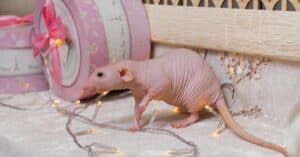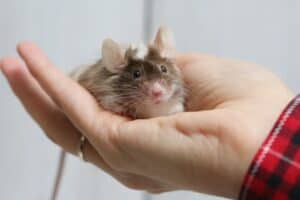African soft fur rats are also known as multimammate mice or Natal rats. They are multimammate mammals as they have eight to 12 mammary glands. Because these rodents breed quickly, reptile breeders and owners use them as a food source. But even though they are food for other animals and reptiles, African soft fur rats make good pets.
African Soft Fur Rats as Pets
As adorable as these rodents are, you need some basic understanding of African soft fur rats if you want to keep them as pets. It’s humane to keep these rats in a cage as long as they are kept in groups of three or more. This rodent type lives in packs so they will become depressed if they live alone. These rats are social mammals and depend on their pack or colony for entertainment, grooming, support, and companionship.
The cage or aquarium in which you keep them must be warm because these rats originate in southern Africa, which has a warm climate, which is what they prefer. So, the temperature in their cage or aquarium should not drop below 60 degrees Fahrenheit and should be kept consistently between 72 and 86 degrees Fahrenheit.
Ideally, the African soft fur rat should have at least 12″ x 12″ x 12″ of space to live comfortably, but a more extensive habitat is even better. For example, when keeping these rodents as pets, you could keep them in a large wire cage with appropriately spaced bars or a big glass aquarium.
Wire Cage
Wire cages are arguably the best living choice for these pets. However, the wire cage must be large with multiple levels for the pack or colony to move around. In addition, keeping the rat pups in a wire cage is not advisable since they are small enough to squeeze through the wire bars. Moreover, it is easier to clean wire cages than aquariums as you only need soap and water to clean the base and the wire of the cage.
Glass Aquarium
When using a glass aquarium for your pets, it should be at least a 20-gallon length container. Unlike wire cages, aquariums offer a clear view for the rats, which they cannot easily escape. Also, ensure you buy an aquarium with a lid made of wire mesh or vents to allow enough ventilation to flow through the area. When cleaning a glass aquarium, you should allow sufficient time for it to dry, as this will help prevent bacterial growth that can cause your pets to become sick.
Toys for Your Pet
The African soft fur rat’s enclosure needs a water container, food bowl, and a little house, “hide,” or enclosed space with bedding. When you buy these rats as pets, you also need to entertain them and give them plenty of opportunities to exercise as they are highly active. For example, a metal running wheel is ideal for them to run on and release excess energy. Other objects you can give them for entertainment include paper towel tubes, hammocks bought from a pet store, or cardboard boxes.

African soft fur rats require a minimum of 12″ x 12″ x 12″ of space to be healthy and happy.
©Rosa Jay/Shutterstock.com
Diet
African soft fur rats are omnivores and feed on mealworms, wax worms, vegetables, and seeds. If you keep these animals as pets, they need food and water at all times. As a dietary alternative, some pet owners choose to feed their rats with dog kibble spattered with millet spray.
Just as a note of warning, you should not give these pets carbonated, caffeinated, or alcoholic beverages or foods. Neither should you feed these rats with candy, avocado, or fruit peels.
Identifying an African Soft Fur Rat
Adult African soft fur rats grow to a size of 6 inches, with tails of about 4.5 inches in length. These rats will reach an average weight of approximately 2.1 ounces, and their fur varies between yellow, brown, and grey. Typically, their undersides are lighter in color than their backs. Notably, this species has long, soft, silky fur, which leads to the name. Additionally, these rats resemble mice. They have a face that is relatively small when compared to their bodies, which is framed by small round ears.
Where Are African Soft Fur Rats Found?
As the name suggests, these rats are native to Africa. You will commonly find these rats in southern Africa and West Africa. However, the wild population of African soft fur rats has declined in recent years. This decline may be due to competition with other rodents, like the black rat. Or, it might be due to their environment and lack of suitable food sources.
African soft fur rats often live in the open Savannah, fields, and marshes. However, these rats also inhabit human settlements. Moreover, these rodents frequently find shelter and build nests in barns, homes, and outbuildings. But, they will typically avoid urban areas as they cannot compete with larger, more aggressive rodents like the black rat.
Reproduction
African soft fur rats breed extremely fast, and female rats (or “does,” as they are also known) can produce a litter every three to four weeks. These rats attain sexual maturity when they are two to three months old and ovulate every four days. Does are pregnant for 21 days and give birth to litters with six to 22 rat pups. Always keep the pups close to their parents to avoid stunting their growth.
Lifespan
Rats generally live for two years, but African soft fur rats live about 33% longer (up to three years) in captivity. Records show that some African soft fur rats as pets have lived for up to seven years, but this is uncommon. In contrast, wild rats generally live for shorter periods of one to two years because of predators in their outdoor environments.
The photo featured at the top of this post is © viper345/Shutterstock.com
Thank you for reading! Have some feedback for us? Contact the AZ Animals editorial team.






